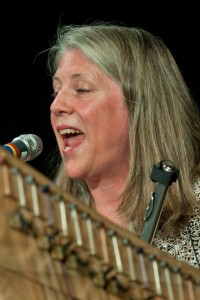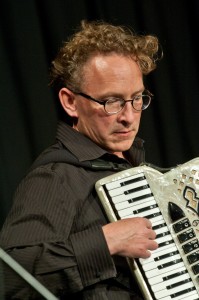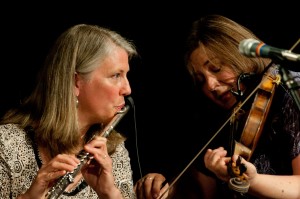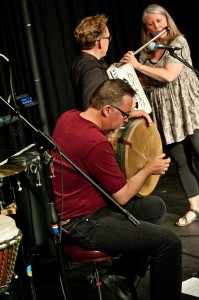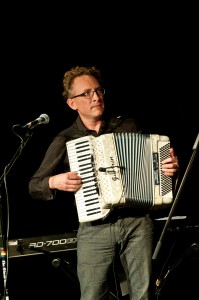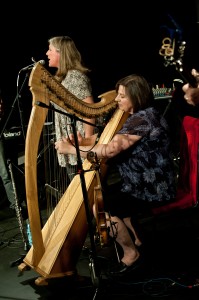CELTARA at Centre 64: Wednesday August 15, 2012, 7:30 pm
 Celtic music can cover a pretty wide spectrum of styles and places of origin. From the “green beer and shamrock”, rip up the floor boards and blister the paint of a St. Patrick Day bar music scene to the precise, somewhat academic music favoured by the
Celtic music can cover a pretty wide spectrum of styles and places of origin. From the “green beer and shamrock”, rip up the floor boards and blister the paint of a St. Patrick Day bar music scene to the precise, somewhat academic music favoured by the  Chieftains. The blister the paint school grew out of the music of the Clancy Brothers, the Dubliners and the Irish Rovers in the 1960’s. They are well remembered for their recordings and the repertoire that has filtered into mainstream music. To this day this style of music is mostly song based and is great fun for a party. Occasionally a few dance tunes are thrown into the mix to get the feet tapping. Great Big Sea and the Pogues are recent popular manifestations of this school of Celtic music. Since the heady days of the Dubliners there has been steady growth in the number of musicians who have chosen to delve deeper into the well of traditional dance music. The Chieftains are still on the scene with their somewhat sedate ambience but they have been joined by bands with a more robust interpretation of the tradition. The Bothy Band set the pace in the seventies and since that time bands like Altan and Lunasa continue to expand the tradition.
Chieftains. The blister the paint school grew out of the music of the Clancy Brothers, the Dubliners and the Irish Rovers in the 1960’s. They are well remembered for their recordings and the repertoire that has filtered into mainstream music. To this day this style of music is mostly song based and is great fun for a party. Occasionally a few dance tunes are thrown into the mix to get the feet tapping. Great Big Sea and the Pogues are recent popular manifestations of this school of Celtic music. Since the heady days of the Dubliners there has been steady growth in the number of musicians who have chosen to delve deeper into the well of traditional dance music. The Chieftains are still on the scene with their somewhat sedate ambience but they have been joined by bands with a more robust interpretation of the tradition. The Bothy Band set the pace in the seventies and since that time bands like Altan and Lunasa continue to expand the tradition.  So between the Pogues and Lunasa there are various shadings of how Celtic music can be played. And off to the side, there are various regional styles of the music. Fiddle music from Cape Breton and Scotland and bagpipe music from Galicia (Spain) are just a couple of examples. While guitars are used the music is more noted for its reliance on the traditional flute, penny whistle, fiddle, harp, concertina, accordion and more recently Irish Bouzouki.
So between the Pogues and Lunasa there are various shadings of how Celtic music can be played. And off to the side, there are various regional styles of the music. Fiddle music from Cape Breton and Scotland and bagpipe music from Galicia (Spain) are just a couple of examples. While guitars are used the music is more noted for its reliance on the traditional flute, penny whistle, fiddle, harp, concertina, accordion and more recently Irish Bouzouki.
And where does Celtara fit in this scheme of things? Well they are some where in the middle. The traditional songs are there (“The Bonnie Ship the Diamond”, “P Stands or Paddy”) as well as the traditional dance tunes. They string the dance tunes together in the time  honored tradition of three or more played without a break. The normal predictable cadences that end a Bluegrass or pop tune are missing. Like most Celtic bands of this ilk, tunes are strung together and the aim for a good, or even great, performance is for flawless smooth transitions from one tune to another. In some instances it is like the shifting of gears in a luxury car, smoothly without notice and then all of a sudden things can just take off. Like motoring a mountain road the musicians navigate the twists and turns of the tunes in the set. Remember this is dance music and a one tune dance doesn’t cut it. There is a huge reservoir of tunes to pick from and Celtara is adding to the list with their own original tunes. In their “The Gap Tooth Set” they included a new tune by Tammi Cooper called “Spillamacheen”. Included in another dance set was the tune with the unusual title “Grannie Hold the Candle while I Shave the Chickens Lips” (????).
honored tradition of three or more played without a break. The normal predictable cadences that end a Bluegrass or pop tune are missing. Like most Celtic bands of this ilk, tunes are strung together and the aim for a good, or even great, performance is for flawless smooth transitions from one tune to another. In some instances it is like the shifting of gears in a luxury car, smoothly without notice and then all of a sudden things can just take off. Like motoring a mountain road the musicians navigate the twists and turns of the tunes in the set. Remember this is dance music and a one tune dance doesn’t cut it. There is a huge reservoir of tunes to pick from and Celtara is adding to the list with their own original tunes. In their “The Gap Tooth Set” they included a new tune by Tammi Cooper called “Spillamacheen”. Included in another dance set was the tune with the unusual title “Grannie Hold the Candle while I Shave the Chickens Lips” (????).
The musicians are from Edmonton and include Tammi Cooper (flute and Irish whistle and vocals) Bonnie Gregory (fiddle, harp and vocals), Steve Bell (keyboard and accordion), Andreas Illig ( Irish  Bouzouki and Guitar) and Mark Arnison (percussion). The flute, fiddle, harp and accordion all have well established pedigrees in traditional Celtic music. Although it should be mentioned that Bonnie’s harp was built in Western Canada so it is somewhat home grown. The Irish Bouzouki is a recent invention, if that’s the right word. Irish musicians visiting the Balkans in the 1960’s became enamored with the Greek Bouzouki and they took it back to Ireland where they had them built with flat backs and changed the tuning to fit Irish music. The Irish Bouzouki is a common feature in Celtic bands.The band Great Big Sea uses the Bouzouki and even Steve Earle showed up at the Key City in Cranbrook recently with an Irish Bouzouki. Andreas Illig plays a beautiful Irish built Foley Bouzouki. Guitars are a fairly recent addition to Irish traditional music and generally requires a different approach to tuning and how it is played. Andreas plays a Collins dreadnought guitar tuned in DADGAD (guitarists will know what that means) . Bones and Bodhran (Irish Frame Drum) are the only traditional Celtic percussion instruments that I know of, but that is changing.Traditional bands are now known to use Congas, Darbukas, and Djembes and just about anything that they can hit, shake or rattle. Mark Arnison uses a Djembe (from West Africa), tube drums (home made from plumbing pipe) and a variety of cymbals and shakers. He also plays the Bodhran but not always in the Irish style. During performances he switched back and forth from the traditional beater to a Middle Eastern hand drumming style where the Bodhran is nursed in the lap and played with both hands.
Bouzouki and Guitar) and Mark Arnison (percussion). The flute, fiddle, harp and accordion all have well established pedigrees in traditional Celtic music. Although it should be mentioned that Bonnie’s harp was built in Western Canada so it is somewhat home grown. The Irish Bouzouki is a recent invention, if that’s the right word. Irish musicians visiting the Balkans in the 1960’s became enamored with the Greek Bouzouki and they took it back to Ireland where they had them built with flat backs and changed the tuning to fit Irish music. The Irish Bouzouki is a common feature in Celtic bands.The band Great Big Sea uses the Bouzouki and even Steve Earle showed up at the Key City in Cranbrook recently with an Irish Bouzouki. Andreas Illig plays a beautiful Irish built Foley Bouzouki. Guitars are a fairly recent addition to Irish traditional music and generally requires a different approach to tuning and how it is played. Andreas plays a Collins dreadnought guitar tuned in DADGAD (guitarists will know what that means) . Bones and Bodhran (Irish Frame Drum) are the only traditional Celtic percussion instruments that I know of, but that is changing.Traditional bands are now known to use Congas, Darbukas, and Djembes and just about anything that they can hit, shake or rattle. Mark Arnison uses a Djembe (from West Africa), tube drums (home made from plumbing pipe) and a variety of cymbals and shakers. He also plays the Bodhran but not always in the Irish style. During performances he switched back and forth from the traditional beater to a Middle Eastern hand drumming style where the Bodhran is nursed in the lap and played with both hands. 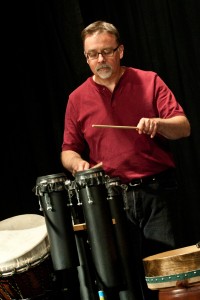 His percussion accompaniments were subtle and always there. Never loud or overbearing. Like all good percussionists he was under the music adding colour and pulse. Celtara plays very finely crafted music that places an emphasis on being in tune with smooth transitions from one instrument to another. Tammi explained that they way back they had a teacher who had the motto “Tune or Die” tacked to his wall. It is a lesson that has stuck. So the music was a superb mix of traditional songs, sad and happy, and a great sampling of dance tunes. The sound system was superb and transparent. It was easy to forget that they were even using a sound system.
His percussion accompaniments were subtle and always there. Never loud or overbearing. Like all good percussionists he was under the music adding colour and pulse. Celtara plays very finely crafted music that places an emphasis on being in tune with smooth transitions from one instrument to another. Tammi explained that they way back they had a teacher who had the motto “Tune or Die” tacked to his wall. It is a lesson that has stuck. So the music was a superb mix of traditional songs, sad and happy, and a great sampling of dance tunes. The sound system was superb and transparent. It was easy to forget that they were even using a sound system.
This is the the Edmonton band’s first visit to the area and one hopes it is the first of many.
Here are more images from the concert: (click on the images for a larger view)

